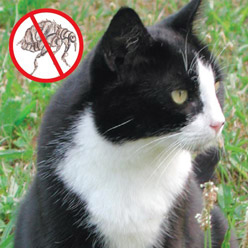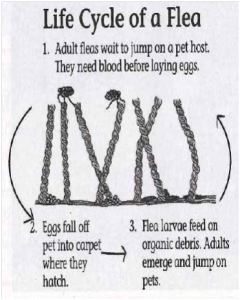Adult fleas spend most of their time in carpets and upholstery, only jumping onto your pets (or you) when reproducing. A female flea needs a drink of blood before she can lay eggs, which are then usually laid directly on the host animal. Flea eggs are round and light-colored. They are not attached to the infested dog or cat in any way, and they quickly roll off. Because of this, your pet’s favorite resting place is also likely to be your home’s main flea nursery.
The eggs hatch within a few days of laying. The emerging larvae look like white worms, though they’re too small to be easily seen by the naked eye. Larvae live in floor cracks, carpets, upholstered furniture and pet bedding. They can eat (and thrive on) virtually any all-natural matter, including dust.
The larval stage lasts between a week and a month, after which the larvae form silken cocoons and enter the pupal stage. These pupal cocoons become encrusted with sand and dust and are thus all but impossible to spot. The adult is fully formed after a week or two but won’t emerge until it senses something warm (like your cat or your leg) nearby.
Any flea control program requires several methods of eradication and treatment before your infestation is eliminated. Here are some suggestions for all-natural flea control, which you’ll find fairly easy to do successfully.
Flea Bath
A flea bath should be your next step towards reducing your pet’s flea population, and may be a necessity for thick-furred animals which are hard to comb. Flea baths work primarily by drowning the pests. While you can achieve some control with water alone, you’ll greatly increase the effectiveness of the bath by adding an all-natural soap containing a mild insecticide.
Applicable Treatment
Several of our products are designed to repair the damage done by flea allergies. Pets Alive! relieves pets’ itching and sore skin. Among Pets Alive! ingredients, there are no products made from corn, a common pet allergen. It’s very effective in soothing the annoying and painful itch that drives pets (and pet owners) to distraction. It also contains garlic and yeast, which are known flea repellents.
Bio-Essential Flea and Tick Spot Treatment is a natural treatment for use on dogs – think of the conventional flea control treatments, but without some of the hazardous chemicals. Bio-Essential is made from essential plant oils, and has been proven effective at killing pests on contact after treatment.

I.G. Regulator provides effective, long-term control and inhibits re-infestation by fleas for up to 7 months!
Indoor Flea Control
What should you do when your concern isn’t just an itchy pet, but an infested home?
The active ingredient in our IG Regulator is NylarÒ , an insect growth regulator. NylarÒ is similar to insect growth hormones that occurs naturally in insects and acts on the immature life stages of the flea, preventing the adult flea from developing. Flea eggs deposited on treated areas will not develop into adult fleas, nor will flea larvae crawling onto treated surfaces. For a minor flea issue in the home, this growth regulator is a great alternative to a full-on insecticide blast.
To further decrease the threat of your flea population expanding, invest in a flea trap. I actually quite like the one from Gardens Alive!- it’s another chemical-free solution. The light trap uses a nightlight bulb to attract and trap bugs – it works by snaring adult fleas attracted to the light, heat and infra-red rays from a 5-watt or smaller nightlight bulb. Instead of plaguing your pet, the fleas jump on a sticky pad under the light. Trapping just one female flea can prevent 200 or more eggs being laid! Each pad captures and holds up to 10,000 fleas.
Outdoor Flea Control
Grub-Away Nematodes have been shown to be effective in controlling flea larvae in your lawn – often the source of your pet’s flea infestation. Just spray it on the areas of your lawn where pets often stroll or play.
All this may sound like a lot of work, but most pet owners will never have to resort to all the measures described here. Determine the frequency and level of your flea control efforts by checking how many fleas you find on the comb each time you comb your pet.

